Files in this item
Three dimensional MHD simulations of the dynamics and energetics of coronal flux tubes
Item metadata
| dc.contributor.advisor | De Moortel, Ineke | |
| dc.contributor.author | Howson, Thomas Alexander | |
| dc.coverage.spatial | [18], 196 p. | en_US |
| dc.date.accessioned | 2019-04-12T11:10:28Z | |
| dc.date.available | 2019-04-12T11:10:28Z | |
| dc.date.issued | 2019-06-25 | |
| dc.identifier.uri | https://hdl.handle.net/10023/17512 | |
| dc.description.abstract | In this thesis we present the results of three-dimensional MHD simulations of the evolution of magnetic flux tubes within the solar atmosphere. We consider the dynamics and energetics of coronal loops that are perturbed from an equilibrium state by wave motions or driven continuously by an imposed velocity field. In each case, we investigate the dissipation of magnetic and kinetic energy and evaluate the implications for the heating of coronal plasma. We present models of transversely oscillating flux tubes which experience rapid damping as kink mode energy is transferred into azimuthal Alfven modes. This mode conversion is typically associated with a density enhancement within the flux tube, however, we demonstrate that it can also proceed with an increased internal magnetic field strength. In either regime, the azimuthal wave modes are subject to dissipation through phase mixing and may promote the development of the magnetic Kelvin-Helmholtz instability. This is associated with the generation of further small scales in the magnetic and velocity fields and, in a non-ideal regime, will enhance the rate of wave dissipation. We show that the growth rate of the instability is sensitive to the implemented transport coefficients and the presence of helical magnetic field. Additionally, we consider the effects of thermal conduction and optically thin radiation on the evolution of a flux tube tectonics model. We present the results of simulations in which two magnetic flux tubes are twisted around each other by the action of rotational drivers imposed at the loop foot points. Large currents develop at the interface of the flux tubes and magnetic reconnection is triggered as the braiding progresses. The inclusion of conduction and optically thin radiation reduces the high temperatures and gas pressures observed in the centre of the numerical domain. As a result, these processes modify the reconnection outflows, distribution of plasma and the evolution of the magnetic field. | en_US |
| dc.language.iso | en | en_US |
| dc.publisher | University of St Andrews | |
| dc.rights | Attribution-NonCommercial-NoDerivatives 4.0 International | * |
| dc.rights.uri | http://creativecommons.org/licenses/by-nc-nd/4.0/ | * |
| dc.subject | Magnetohydrodynamics (MHD) | en_US |
| dc.subject | Coronal waves | en_US |
| dc.subject | Coronal heating | en_US |
| dc.subject.lcc | QB539.M23H7 | |
| dc.subject.lcsh | Sun--Corona--Magnetic fields--Mathematical models | en |
| dc.subject.lcsh | Magnetohydrodynamics--Mathematical models. | en |
| dc.title | Three dimensional MHD simulations of the dynamics and energetics of coronal flux tubes | en_US |
| dc.type | Thesis | en_US |
| dc.contributor.sponsor | Science and Technology Facilities Council (STFC) | en_US |
| dc.contributor.sponsor | Horizon 2020 (Programme) | en_US |
| dc.type.qualificationlevel | Doctoral | en_US |
| dc.type.qualificationname | PhD Doctor of Philosophy | en_US |
| dc.publisher.institution | The University of St Andrews | en_US |
| dc.identifier.doi | https://doi.org/10.17630/10023-17512 |
The following licence files are associated with this item:
This item appears in the following Collection(s)
Except where otherwise noted within the work, this item's licence for re-use is described as Attribution-NonCommercial-NoDerivatives 4.0 International
Items in the St Andrews Research Repository are protected by copyright, with all rights reserved, unless otherwise indicated.


